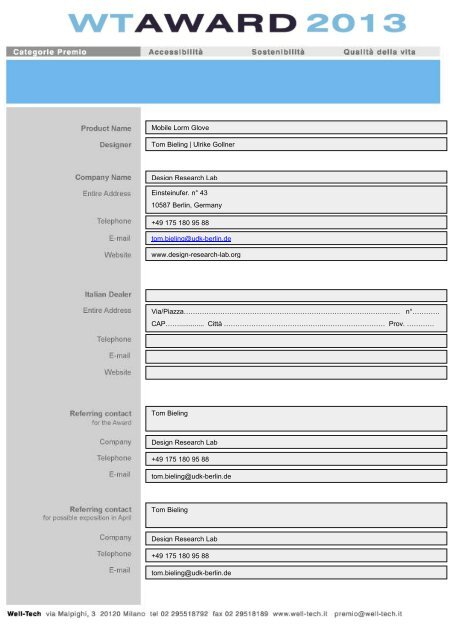Mobile Lorm Glove Tom Bieling | Ulrike Gollner ... - Well-Tech
Mobile Lorm Glove Tom Bieling | Ulrike Gollner ... - Well-Tech
Mobile Lorm Glove Tom Bieling | Ulrike Gollner ... - Well-Tech
You also want an ePaper? Increase the reach of your titles
YUMPU automatically turns print PDFs into web optimized ePapers that Google loves.
<strong>Mobile</strong> <strong>Lorm</strong> <strong>Glove</strong><br />
<strong>Tom</strong> <strong>Bieling</strong> | <strong>Ulrike</strong> <strong>Gollner</strong><br />
Design Research Lab<br />
Einsteinufer. n° 43<br />
10587 Berlin, Germany<br />
+49 175 180 95 88<br />
tom.bieling@udk-berlin.de<br />
www.design-research-lab.org<br />
Via/Piazza……………………………………………………………………….……….… n°…………<br />
CAP……............. Città ……………………………………..……………………… Prov. …………<br />
<strong>Tom</strong> <strong>Bieling</strong><br />
Design Research Lab<br />
+49 175 180 95 88<br />
tom.bieling@udk-berlin.de<br />
<strong>Tom</strong> <strong>Bieling</strong><br />
Design Research Lab<br />
+49 175 180 95 88<br />
tom.bieling@udk-berlin.de
Marginalized communities like deaf-blind people are excluded from several forms of<br />
communication. The Design Research Lab has been developing the <strong>Mobile</strong> <strong>Lorm</strong> <strong>Glove</strong>, a<br />
mobile communication and translation device for the deaf-blind. The prototype translates the<br />
hand-touch alphabet “<strong>Lorm</strong>”, a common form of communication used by people with both<br />
hearing and vision impairment, into text and vice versa.<br />
The <strong>Mobile</strong> <strong>Lorm</strong> <strong>Glove</strong> provides particularly two innovative ways of communication for<br />
deafblind people. It supports mobile communication over distance, e.g. text messages, SMS,<br />
chat or email, and it enables parallel one-to-many communication, which is especially helpful in<br />
school and other learning contexts. The impact is even stronger, when direct speech in- and<br />
output is implemented. With this newly developed interaction technology, it will also soon<br />
become possible to “feel” E-Books or Audiobooks.<br />
The <strong>Mobile</strong> <strong>Lorm</strong> <strong>Glove</strong> functions as a simultaneous translator and makes communicating with<br />
others without knowledge of “<strong>Lorm</strong>” possible. As a result, it empowers deafblind people to<br />
engage with a wider social world, gain access to a broader range of information, and further<br />
enhances their independence.<br />
Short Video Link (2 min.): http://www.design-research-lab.org/?projects=mobile-lorm-glove<br />
Textile pressure sensors located on the palm of the glove enable the deafblind user to “lorm” on<br />
his or her own hand to compose text messages. A Bluetooth® connection transmits the data<br />
from the glove to the user’s handheld device. It is then automatically forwarded to the receiver’s<br />
handheld device in the form of an SMS. If the wearer of the <strong>Mobile</strong> <strong>Lorm</strong> <strong>Glove</strong> receives a text<br />
message, the message will be forwarded via Bluetooth® from his or her handheld device to the<br />
glove. Initiated by small vibration motors located on the back of the glove, tactile feedback<br />
patterns allow the wearer to perceive incoming messages.<br />
200 x 111 x 30 mm<br />
The hand glove is made of stretchy fabric equipped with an input unit (35 fabric pressure<br />
sensors) on the palm of the glove and an output unit (32 shaftless coin vibrating motors) on the<br />
back of the glove. The control unit is integrated in a light case mounted on the forearm.<br />
Although physical presence of conversation partners is an important good for deaf-blind people,<br />
it is often not possible, because the carers can not be present all the time. With the <strong>Mobile</strong><br />
<strong>Lorm</strong> <strong>Glove</strong>, a “permanent presence” becomes possible. This also means, that carers do not<br />
always have to e.g. drive long distances by car, to meet their “patients”, but can also be “in<br />
touch” over distance.<br />
We found a way to include a strongly marginalized and excluded group like the deaf-blind to be<br />
included into society. On the other hand, this group’s specific way of communication, might also<br />
be an inspiration to other fields: That’s why we are currently investigating on different areas of<br />
operation, where such kind of haptic interaction could be embedded into wearable<br />
technologies. Let‘s think about machine workers in loud environments, or situations where<br />
people either must not or can not speak loud (e.g. stage-hands in a theater).<br />
So the point is:<br />
If we learn to acknowledge the expertise of disabled people, we might not only be able to come<br />
up with good stuff that makes the world a little bit more accessible to all of us,







![Disko SU1 [sun unit one] DESIGN & INNOVATION ... - Well-Tech](https://img.yumpu.com/33580509/1/184x260/disko-su1-sun-unit-one-design-innovation-well-tech.jpg?quality=85)




